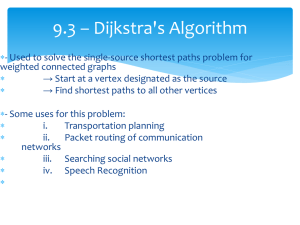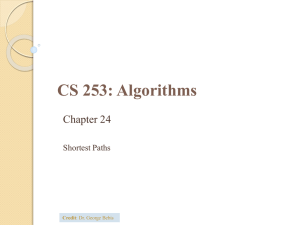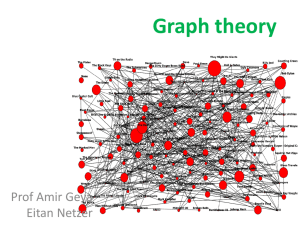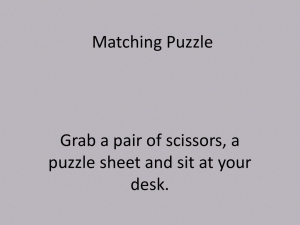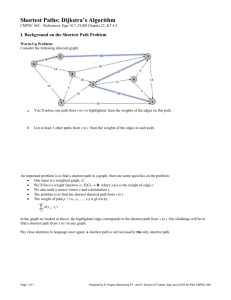CSE 373: Data Structures and Algorithms
advertisement
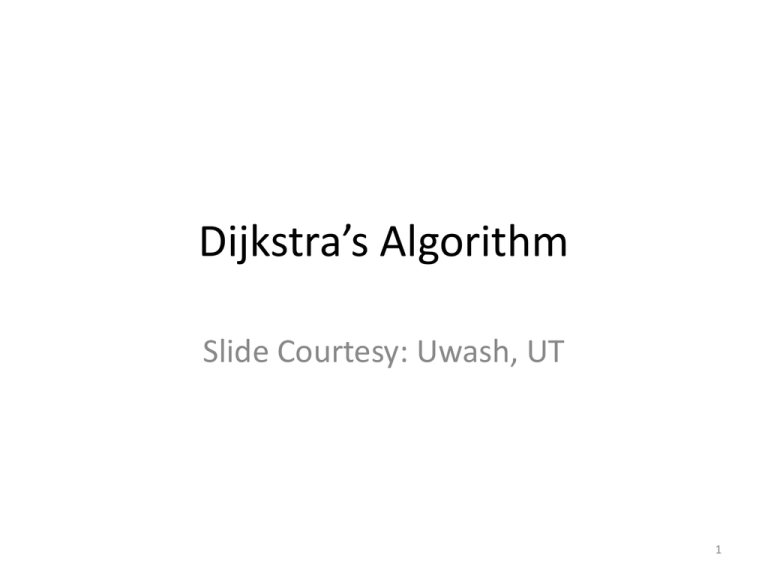
Dijkstra’s Algorithm
Slide Courtesy: Uwash, UT
1
Single-Source Shortest Path Problem
Single-Source Shortest Path Problem - The
problem of finding shortest paths from a source
vertex v to all other vertices in the graph.
Applications
- Maps (Map Quest, Google Maps)
- Routing Systems
Dijkstra's algorithm
Dijkstra's algorithm - is a solution to the single-source
shortest path problem in graph theory.
Works on both directed and undirected graphs. However,
all edges must have nonnegative weights.
Input: Weighted graph G={E,V} and source vertex v∈V,
such that all edge weights are nonnegative
Output: Lengths of shortest paths (or the shortest paths
themselves) from a given source vertex v∈V to all other
vertices
Approach
• The algorithm computes for each vertex u the distance to u
from the start vertex v, that is, the weight of a shortest path
between v and u.
• the algorithm keeps track of the set of vertices for which the
distance has been computed, called the cloud C
• Every vertex has a label D associated with it. For any vertex u,
D[u] stores an approximation of the distance between v and
u. The algorithm will update a D[u] value when it finds a
shorter path from v to u.
• When a vertex u is added to the cloud, its label D[u] is equal
to the actual (final) distance between the starting vertex v and
vertex u.
5
Dijkstra pseudocode
Dijkstra(v1, v2):
for each vertex v:
v's distance := infinity.
v's previous := none.
v1's distance := 0.
List := {all vertices}.
// Initialization
while List is not empty:
v := remove List vertex with minimum distance.
mark v as known.
for each unknown neighbor n of v:
dist := v's distance + edge (v, n)'s weight.
if dist is smaller than n's distance:
n's distance := dist.
n's previous := v.
reconstruct path from v2 back to v1,
following previous pointers.
6
Example: Initialization
0
Distance(source) =
0
∞
2
A
1
4
∞
2
C
5
F
∞
B
3
10
2
D
8
∞
1
Distance (all vertices
but source) = ∞
4
E
∞
6
G
∞
Pick vertex in List with minimum distance.
7
Example: Update neighbors'
distance
0
2
2
A
1
4
∞
2
C
5
Distance(B) = 2
Distance(D) = 1
∞
3
10
2
D
8
F
B
1
1
4
E
∞
6
G
∞
8
Example: Remove vertex with
minimum distance
0
2
2
A
1
4
∞
2
C
5
∞
3
10
2
D
8
F
B
1
1
4
E
∞
6
G
∞
Pick vertex in List with minimum distance, i.e., D
9
Example: Update neighbors
0
2
2
A
1
4
3
2
C
5
Distance(C) = 1 + 2 = 3
Distance(E) = 1 + 2 = 3
Distance(F) = 1 + 8 = 9
Distance(G) = 1 + 4 = 5
9
3
10
2
D
8
F
B
1
1
4
E
3
6
G
5
10
Example: Continued...
Pick vertex in List with minimum distance (B) and update neighbors
0
2
2
A
1
4
3
2
C
5
9
3
10
2
D
8
F
B
1
1
4
E
3
6
G
5
Note : distance(D) not
updated since D is
already known and
distance(E) not updated
since it is larger than
previously computed
11
Example: Continued...
Pick vertex List with minimum distance (E) and update neighbors
0
2
2
A
1
4
3
2
C
5
9
3
10
2
D
8
F
B
1
1
4
E
3
6
G
No updating
5
12
Example: Continued...
Pick vertex List with minimum distance (C) and update neighbors
0
2
2
A
1
4
3
2
C
5
Distance(F) = 3 + 5 = 8
8
3
10
2
D
8
F
B
1
1
4
E
3
6
G
5
13
Example: Continued...
Pick vertex List with minimum distance (G) and update neighbors
0
2
2
A
1
4
3
2
C
5
3
10
2
D
8
F
B
1
1
4
E
3
6
G
Previous distance
6
5
Distance(F) = min (8, 5+1) = 6
14
Example (end)
0
2
2
A
1
4
3
2
C
5
6
3
10
2
D
8
F
B
1
1
4
E
3
6
G
5
Pick vertex not in S with lowest cost (F) and update neighbors
15
Another Example
Another Example
Another Example
Another Example
Another Example
Another Example
Another Example
Another Example
Another Example
Correctness :“Cloudy” Proof
When a vertex is added to the cloud, it has shortest
distance to source.
Least cost node v
competitor
v'
P: Next shortest path from
inside the known cloud
THE KNOWN
CLOUD
Source
• If the path to v is the next shortest path, the path to v' must be at
least as long. Therefore, any path through v' to v cannot be shorter!
Dijkstra’s Correctness
• We will prove that whenever u is added to S, d[u] =
d(s,u), i.e., that d[u] is minimum, and that equality is
maintained thereafter
• Proof
– Note that for all v, d[v] ≥ d(s,v)
– Let u be the first vertex picked such that there is a shorter
path than d[u], i.e., that d[u] > d(s,u)
– We will show that this assumption leads to a contradiction
26
Dijkstra Correctness (2)
• Let y be the first vertex in V – S on the actual shortest
path from s to u, then it must be that d[y] = d(s,y)
because
– d[x] is set correctly for y's predecessor x in S on the shortest
path (by choice of u as the first vertex for which d is set
incorrectly)
– when the algorithm inserted x into S, it relaxed the edge
(x,y), assigning d[y] the correct value
27
Dijkstra Correctness (3)
d
[
u
] >d
(
s
,)
u
(
i
n
i
t
i
a
la
s
s
u
m
p
t
i
o
n
)
d
(
s
,)
y
d
(
y
,)
u(
o
p
t
i
m
a
ls
u
b
s
t
r
u
c
t
u
r
e
)
d
[
y
]
d
(
y
,)
u (
c
o
r
r
e
c
t
n
e
s
s
o
f
d
[
y
]
)
d
[
y
]
(
n
o
n
e
g
a
t
i
v
e
w
e
i
g
h
t
s
)
• But if d[u] > d[y], the algorithm would have chosen y
(from the Q) to process next, not u -- Contradiction
• Thus d[u] = d(s,u) at time of insertion of u into S, and
Dijkstra's algorithm is correct
28
Dijkstra’s Pseudo Code
• Graph G, weight function w, root s
relaxing
edges
29
Time Complexity: Using List
The simplest implementation of the Dijkstra's algorithm
stores vertices in an ordinary linked list or array
– Good for dense graphs (many edges)
• |V| vertices and |E| edges
• Initialization O(|V|)
• While loop O(|V|)
– Find and remove min distance vertices O(|V|)
• Potentially |E| updates
• Update costs O(1)
Total time O(|V2| + |E|) = O(|V2| )
Time Complexity: Priority Queue
For sparse graphs, (i.e. graphs with much less than |V2| edges)
Dijkstra's implemented more efficiently by priority queue
• Initialization O(|V|) using O(|V|) buildHeap
• While loop O(|V|)
• Find and remove min distance vertices O(log |V|) using O(log |V|)
deleteMin
• Potentially |E| updates
• Update costs O(log |V|) using decreaseKey
Total time O(|V|log|V| + |E|log|V|) = O(|E|log|V|)
• |V| = O(|E|) assuming a connected graph
31



